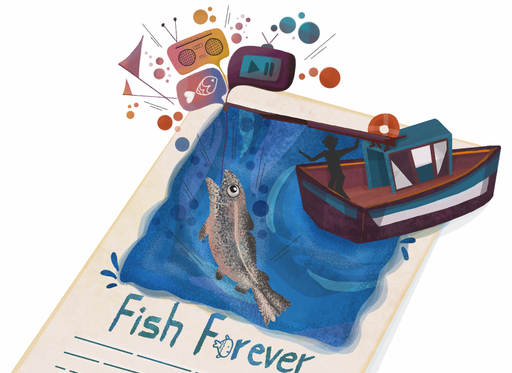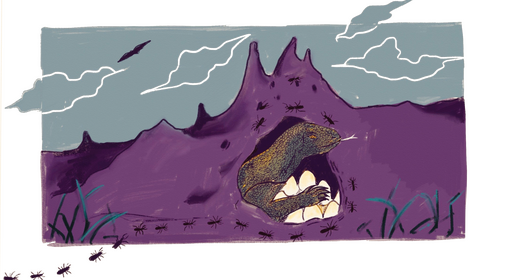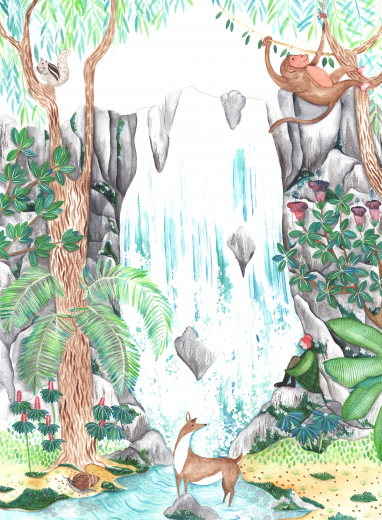
Picture from What Really Happens When We Tame Our Rivers
Through SCB partnerships, we can support like-minded organizations who's missions align with our own, and they can help support us too. One of these partnerships is with Current Conservation, a not-for-profit quarterly print and online magazine that works with scientists, science writers, and artists across the world to tell stories from the field of conservation in a manner that engages both scientific and non-scientific audiences.
We held a Q & A with Current Conservation Editor Kartik Shanker so our members can learn more about why were working together, what Current Conservation hopes to accomplish, and why the world needs this publication.
Why does the world need Current Conservation?
Current Conservation is a campfire, huddled around which we invite scientists, science writers, and artists across the world to tell stories from the field of conservation, reflecting human-environment relations at their core. Current Conservation aims to capture the messy diversity of life on its canvas, from the simple beauty of landscapes, to the intricacies of ecological relationships, to our complex cultural and political connections with nature. Under the guise of a magazine, it is a space where art meets science, a platform where the visual meets the verbal, a forum where the two cultures can meet, share and learn from each other.
What inspires Current Conservation to tell conservation stories?
Conservation is often portrayed as the noble pursuit of saving endangered species or more grandly, the planet. But, like every other human endeavor, it has its share of successes and failures, of positive outcomes and negative impacts, of sad stories and happy endings. CC aims to bring out all that’s real in conservation – the ingenuity, the creativity, the persistence, the all too human frailty, but most of all, our collective hope for a better future. And in telling these stories, CC hopes to inspire deeper connections with both culture and nature, both for the storytellers and their audience. 
What is CC Kids and what do you hope it accomplishes?
CC Kids serves as a vehicle to communicate our passion for nature, wildlife and conservation to the next generation. To catch them young. We hope that the articles and art help create connections with nature, and that the stories about conservation and conservationists shine a light on what’s possible. As much as that, we believe that telling stories and creating art for children has a certain innocence and exuberance that evokes joy and inspires action.
Why are SCB members an important resource for Current Conservation’s goals to tell conservation stories?
As the largest society of conservation scientists and practitioners, SCB is a great source of nature and conservation stories from around the world, on different species from a range of habitats and a variety of cultural contexts. In addition, the diversity of views and opinions, of perspectives shaped by society, gender and experience can provide a rich vein of material that reflects the present and shapes the future.
How can SCB members get involved and support the work and mission of Current Conservation?
Current Conservation carries the latest in research concepts and news from both the natural and social science facets of conservation. We would like SCB members to submit articles on ecology, wildlife biology, conservation biology, environmental history, anthropology and sociology, ecological economics, and related fields of research. This could include features, short field notes, or even Research in Translation, which are short summaries of individual research papers. We also welcome artwork and illustrations that accompany articles, or as standalone visual stories. And finally, with what we hope is a large inflow of content, we would be happy to consider voluntary editorial assistance.
What does it mean to you personally when Current Conservation publishes a researcher’s story (i.e. Field Notes)?
Our field experiences define us as a community. Field notes bring to life our personal journeys, the hills we’ve climbed, the rivers we’ve rafted on, the trade winds and thermals that helped or hindered our attempts at flight. That frisson of exhilaration at observation or discovery. That trudge of frustration at the end of another long and seemingly fruitless field day. The friends and strangers that made those long and sometimes strange trips challenging or rewarding, or both. Publishing these stories brings us all around the campfire to share the essence of what’s important to us.
Who reads Current Conservation?
At this time, CC serves the larger conservation community, wildlife enthusiasts and younger readers who are interested in nature (or just avoiding more serious reading in their school library). We aim to expand this reach at a global level to facilitate communication within this community and draw in those at the edges of our field. In future, we also aim to disseminate our philosophy and ideas to a larger public audience. 
Do you have anything else to add?
Current Conservation believes in a philosophy of pluralism in how we carry out conservation, as well as how communicate it. We believe that species and habitats sometimes need to be protected, and at other times hunted or used. It depends. Sometimes a story needs to be short, at other times long; sometimes in prose, and at other times in verse. And a picture always says more than a thousand words.
CC is hosted by Dakshin Foundation and owes much to its long-term donors in the conservation community in India. As an open access publication, we survive on the support of our partners and contributions are always welcome.
